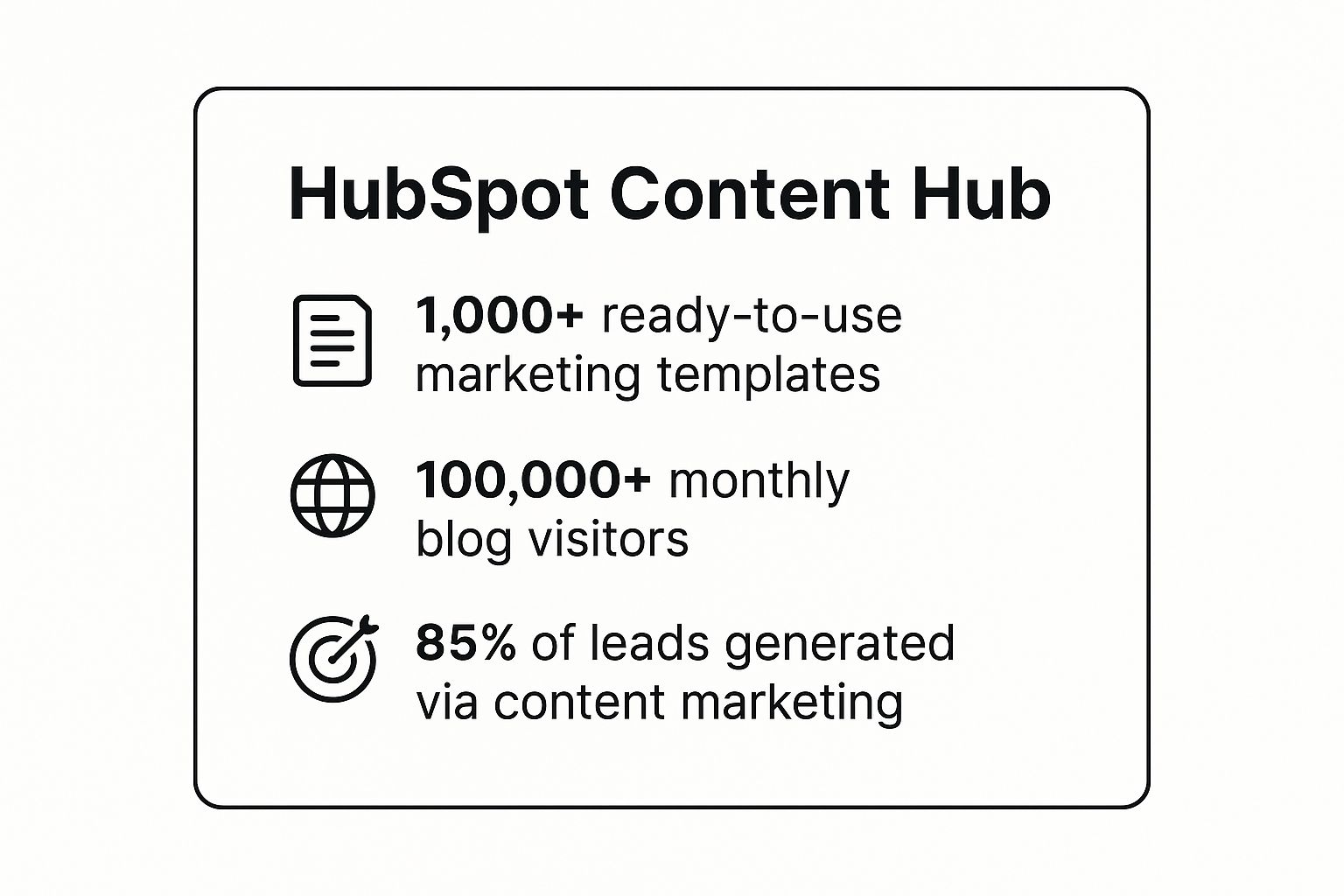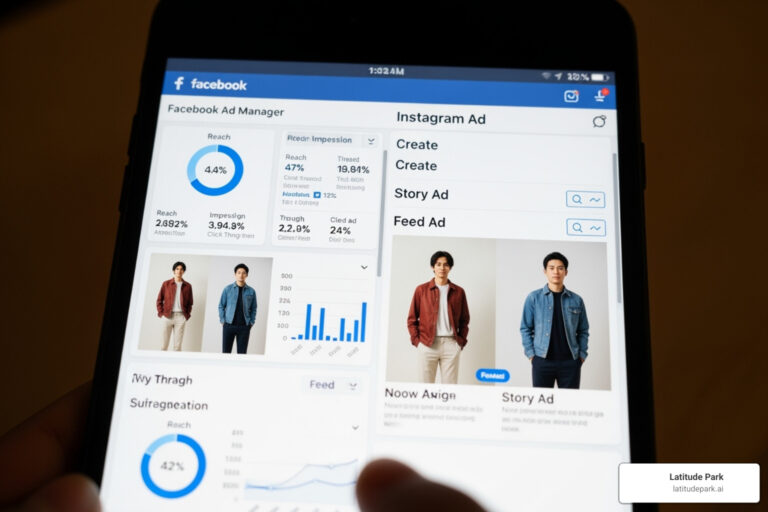Content strategy is more than just publishing blog posts or creating social media updates. It's the high-level, deliberate plan that connects every piece of content you create directly to your core business goals. A powerful strategy doesn't just attract an audience; it builds a loyal community, establishes authority, and drives measurable growth. But what does a truly effective content strategy look like in the real world?
Instead of relying on abstract theories, this article dives deep into tangible examples of content strategy from eight brands that have mastered the craft. We will deconstruct the "how" and "why" behind their success, moving beyond surface-level descriptions to provide a strategic blueprint. For each brand, from HubSpot's educational empire to Red Bull's adrenaline-fueled storytelling, we will dissect their core approach and specific tactics.
You won't find generic success stories here. Instead, you'll get a detailed breakdown of each strategy, complete with performance insights and, most importantly, actionable takeaways. We'll explore how these companies align their content with specific business objectives, from building brand awareness to driving sales and fostering customer loyalty. This analysis is designed to give business and franchise owners a clear roadmap, providing replicable methods and practical insights you can adapt and apply to your own marketing efforts. Let's get straight to the examples and see how these winning strategies are built, piece by piece.
1. HubSpot's Educational Content Hub Strategy
HubSpot's approach is one of the most powerful examples of content strategy because it transforms the company from a software provider into an indispensable educational resource. Their strategy is built on the principle of "inbound marketing," which focuses on attracting customers by creating valuable content and experiences tailored to them. Instead of pushing products, they pull prospects in by solving their problems first.
This method works by systematically creating high-quality, comprehensive resources that address user pain points at every stage of the buyer's journey. From top-of-funnel blog posts that attract millions of monthly visitors to bottom-of-funnel templates and free tools, every piece of content is designed to build trust and demonstrate expertise. This positions HubSpot as the go-to authority in marketing and sales.
Strategic Breakdown
The core of HubSpot's success lies in its topic cluster model. They create massive, authoritative "pillar" pages on broad topics like "content marketing" or "SEO." Then, they surround these pillars with dozens of "cluster" articles that cover specific, related subtopics in detail. This structure not only organizes their content for users but also signals a deep level of expertise to search engines, boosting their organic rankings. A practical example is their "Ultimate Guide to Email Marketing" pillar page, which is supported by cluster articles like "How to Write a Welcome Email" and "Best Email Analytics Tools," all linking back to the central guide.
Strategic Insight: HubSpot's strategy is not just about creating content; it's about building an educational ecosystem. By offering free certifications through HubSpot Academy and practical, free tools like the "Website Grader," they embed their brand into the user's professional development and daily workflow, making their software the natural next step. The content is the lead generation machine.
Actionable Takeaways
You can replicate this strategy by focusing on education over promotion. Start by identifying your audience's biggest challenges and build your content around providing solutions.
- Develop a Pillar and Cluster Model: Choose a broad topic your business wants to own, like "Local SEO for Plumbers." Create a comprehensive pillar page and then build out cluster content (e.g., "Google Business Profile Optimization," "Getting Local Reviews") that links back to it.
- Create Content for Every Funnel Stage: Map out your customer's journey. Create an awareness-level blog post ("5 Signs Your Home Has a Hidden Water Leak"), a consideration-stage guide ("How to Choose the Right Plumber"), and a decision-stage case study ("How We Solved a Complex Plumbing Issue for a Local Business").
- Offer Value Beyond Articles: Develop practical tools like a "Home Maintenance Checklist" PDF, a "Leaky Faucet Cost Calculator," or a free mini-course on basic plumbing fixes. These assets are powerful lead magnets and build significant brand loyalty.
The following infographic highlights key data points illustrating the scale and impact of HubSpot's content engine.

This data powerfully demonstrates how providing value through free resources directly translates into massive audience growth and lead generation. You can discover more about building a similar framework by exploring how to develop a B2B content marketing strategy.
2. Red Bull's Brand Storytelling and Extreme Sports Content
Red Bull provides one of the most audacious examples of content strategy by transcending its product entirely. Instead of marketing an energy drink, it has become a global media and entertainment brand. Their strategy is built on associating the Red Bull name with adrenaline, adventure, and human achievement, effectively selling a lifestyle rather than a beverage.
This approach works by creating and funding high-octane, visually spectacular content that embodies the brand's core values. By producing world-class events, films, and documentaries centered on extreme sports and culture, Red Bull captures the attention and imagination of its target audience. The product is rarely the focus; the story and the experience are everything.

Strategic Breakdown
The genius behind Red Bull's strategy is its transformation into a publisher and producer. Through the Red Bull Media House, the company operates like a full-fledged media company, creating content that is so compelling it generates its own audience and revenue. From Felix Baumgartner's record-breaking space jump (Stratosphere), which garnered over 8 million concurrent YouTube viewers, to the Red Bull Rampage mountain biking event, their content isn't an ad; it's the main event.
This allows them to own entire cultural niches, from Formula 1 racing to breakdancing championships. By funding athletes and events, they generate authentic stories that reinforce their brand identity without overt sales pitches, building a deeply loyal community that shares the brand's passion for pushing limits.
Strategic Insight: Red Bull doesn't interrupt what people are interested in; it is what people are interested in. Their content strategy is successful because they invest in creating culture, not just borrowing from it. A key insight here is that the return on investment isn't measured in direct sales per video, but in the massive, long-term brand equity and cultural ownership they build.
Actionable Takeaways
You can apply Red Bull's principles by focusing on lifestyle and storytelling, even on a smaller scale. Connect your brand to your audience's passions rather than just their problems.
- Define Your Brand's "Why": Identify the core values behind your brand. If you sell hiking gear, your "why" isn't just "durable equipment," it's "enabling adventure and connection with nature."
- Invest in High-Quality Storytelling: Focus on creating emotionally resonant, visually appealing content. A local coffee shop could produce a mini-documentary series featuring the local artists and musicians who are regulars, telling their stories instead of just showing latte art.
- Sponsor or Create Niche Events: Identify a passion point for your audience. A local accounting firm could sponsor a "small business pitch competition" for local entrepreneurs, creating content around the event and positioning themselves as champions of local business.
3. Airbnb's User-Generated Content and Community Stories
Airbnb's strategy stands out as one of the best examples of content strategy by putting its community at the heart of its marketing. Instead of solely producing branded content, Airbnb leverages authentic stories, photos, and experiences from its global community of hosts and guests. This approach builds immense trust and creates a powerful emotional connection with its audience.
The core principle is to showcase real travel experiences rather than just selling stays. By amplifying user-generated content (UGC), Airbnb transforms its platform from a transactional booking site into a vibrant collection of human stories. This content, ranging from the #AirbnbPhotoContest to host success stories, feels more relatable and credible than traditional advertising, inspiring wanderlust and confidence in potential bookers.

Strategic Breakdown
Airbnb’s success is rooted in its ability to curate and amplify community-driven narratives. They create platforms and campaigns, like the "Belong Anywhere" campaign, that provide a framework for users to share their unique perspectives. A practical example is their "Host Stories" blog, which features in-depth interviews with hosts, showcasing their unique properties and personal journeys. This not only inspires potential hosts but also provides rich, authentic content for social media and email marketing, creating a scalable engine that constantly supplies fresh material.
Strategic Insight: Airbnb sells an experience, not just a room. Their content strategy is built to celebrate the transformative power of travel and human connection. By focusing on the stories around the stay—the local baker the host recommended, the hidden trail they discovered—they differentiate themselves from faceless hotel chains and build a brand users feel personally invested in.
Actionable Takeaways
You can adopt this community-centric approach by empowering your customers to become your storytellers. Focus on creating opportunities for them to share their experiences authentically.
- Create a Platform for Sharing: A local gym could launch a #MyGymJourney hashtag for members to post workout progress and success stories. A B2B software company could create a "Customer of the Month" feature on its blog.
- Incentivize High-Quality Submissions: Offer a small reward, like a gift card or a discount, for the best user-submitted photo or story each month. Provide clear guidelines, for instance: "We're looking for photos that capture the feeling of adventure you have when using our product."
- Amplify and Repurpose User Content: Showcase the best UGC across all your channels. Turn a great customer tweet into a graphic for Instagram. Use a powerful testimonial in your next ad campaign. Always credit the original creator to foster goodwill and encourage more submissions.
4. Buffer's Transparent and Data-Driven Social Media Strategy
Buffer’s approach is one of the most compelling examples of content strategy because it leverages radical transparency to build an unshakable bond with its audience. Instead of a polished corporate facade, Buffer openly shares its internal operations, from revenue dashboards and salary formulas to its own business challenges and failures. This builds immense trust and humanizes the brand in a crowded SaaS market.
This strategy works by treating the company's journey as the content itself. Buffer creates in-depth articles, reports, and social posts that document its own learnings in real-time. By combining this vulnerability with genuinely helpful, data-backed advice on social media marketing, they attract an audience of like-minded founders, marketers, and professionals who value authenticity and expertise.
Strategic Breakdown
The core of Buffer's strategy is its "default to transparency" value, which permeates all its content. For example, when they made the difficult decision to conduct layoffs, they published a blog post titled "A Difficult Day at Buffer" explaining the business reasons, the process, and the severance packages offered. This level of openness, while risky, generated respect and deep brand loyalty. This is complemented by their annual "State of Social" report, which provides industry-leading data and analysis, solidifying their authority.
Strategic Insight: Buffer’s transparency is not a gimmick; it’s a core business philosophy that fuels its content engine. By sharing the "how" and "why" behind their own business decisions, they create a unique form of content that competitors cannot easily replicate. This authenticity serves as their ultimate moat, turning customers into deeply invested advocates.
Actionable Takeaways
You can adopt a transparency-focused strategy by starting small and building a culture of openness. The goal is to share your journey and learnings to build a loyal community.
- Share Both Wins and Losses: Document a recent campaign. Write a post detailing the goal (e.g., "Increase webinar sign-ups by 20%"), the result ("We only hit 10%, here's what went wrong"), and what you learned. This is far more valuable than a generic success story.
- Create Data-Driven Industry Reports: Survey your audience or customers about a key topic in your niche. A marketing agency could survey 100 local businesses about their biggest marketing challenges and publish a "State of Local Marketing" report with the findings.
- Develop a Transparency Content Series: Commit to a recurring blog or social media series. A startup could share a "Founder's Log" with monthly updates on revenue, challenges, and key decisions. A restaurant could share a breakdown of where its food costs come from to explain pricing.
This approach transforms standard business operations into valuable assets that differentiate your brand. You can explore other ways to engage your audience by understanding the different types of social media content marketing.
5. Netflix's Personalized and Culturally Relevant Content Strategy
Netflix offers one of the most dynamic examples of content strategy by masterfully blending data-driven personalization with rapid-fire cultural relevance. Their approach goes beyond simply promoting shows; it aims to build a relatable, witty, and ever-present brand personality that lives within online conversations. Instead of just broadcasting, Netflix engages in a two-way dialogue with its audience.
This strategy works by leveraging deep user data to understand viewing habits, which informs not only what original content they greenlight but also how they market it. On social media, they act less like a corporation and more like a fan, using memes, inside jokes, and timely commentary to connect with distinct audience segments. This creates an authentic-feeling brand that users actively want to follow and interact with.
Strategic Breakdown
The core of Netflix's strategy is its ability to operate at two speeds: long-term, high-production original content and short-term, highly reactive social content. For example, their Twitter account (@netflix) is famous for its one-line, witty posts that tap into shared viewer experiences, like "what are we all watching tonight or are we just scrolling for 30 minutes and then going to bed." This is complemented by groundbreaking interactive content like Bandersnatch, which turns passive viewing into an active, personalized experience.
Strategic Insight: Netflix's strategy treats its brand voice as a product in itself. The witty, self-aware, and often humorous tone is so consistent that it has become an identifiable brand asset. This allows them to participate in cultural moments, from the Oscars to a viral TikTok trend, in a way that feels natural, not forced. The practical insight is that they've built a brand people want to be friends with online.
Actionable Takeaways
You can adopt this approach by developing a strong brand personality and staying agile enough to join relevant cultural conversations. The goal is to be more than a service provider; it's to be a valued member of your audience's online community.
- Develop a Distinct Brand Voice: Document your brand's personality in a simple guide. For example: "We are the witty expert friend. Voice: clever, helpful, never condescending. Use pop-culture references where relevant."
- Invest in Audience Analytics: Use social listening tools to see what your audience is talking about. A B2B software company might notice their audience is constantly joking about overflowing inboxes, creating an opportunity for a funny, relatable meme about email management.
- Create Agile Content Templates: Prepare templates for memes or simple graphic formats. When a trend breaks, you can quickly drop in your brand's message and join the conversation in minutes, not days.
- Segment Your Platform Strategy: Don't just cross-post. Use LinkedIn for professional, insightful posts based on industry data. Use Instagram Reels to create short, entertaining "how-to" videos that showcase your product in a fun way.
By focusing on personality and timeliness, you can build a more engaging and memorable brand. You can explore how these principles fit into a larger framework by understanding the fundamentals of a digital content strategy.
6. Patagonia's Mission-Driven Environmental Activism Content
Patagonia's approach stands out among examples of content strategy because it is built entirely on its core mission rather than on direct product promotion. The brand leverages its platform for environmental activism, creating content that educates, inspires action, and reinforces its commitment to protecting the planet. This strategy prioritizes values over transactions, building an intensely loyal community that shares its beliefs.
This method works by aligning every piece of content with the company’s reason for being: to save our home planet. From documentaries about environmental crises to campaigns encouraging consumers to buy less, Patagonia’s content demonstrates authenticity and purpose. This builds a powerful brand identity that transcends apparel, positioning Patagonia as a leader in corporate responsibility and activism.
Strategic Breakdown
The core of Patagonia's strategy is its unflinching willingness to take bold, often political, stances that reflect its values. Campaigns like the famous "Don't Buy This Jacket" ad directly challenge consumerism, a move that seems counterintuitive but powerfully reinforces the brand’s commitment to sustainability and product longevity. A practical example of their content is the film DamNation, a feature-length documentary they produced about the environmental impact of dams, which won audience awards at film festivals and raised significant awareness for the cause.
Strategic Insight: Patagonia's strategy proves that a brand's mission can be its most effective marketing tool. By focusing on storytelling that genuinely matters to its audience and backing it up with tangible action (like donating 1% of sales to environmental nonprofits), the company fosters a deep, emotional connection with consumers who buy into the mission, not just the product. The key insight is that for a certain audience, purpose is more persuasive than features.
Actionable Takeaways
You can adopt this mission-driven approach by embedding your company's core values into your content. The key is authenticity and a genuine commitment to the cause you champion.
- Define Your Core Mission: Identify the values that drive your business. A local bookstore's mission could be "fostering community literacy." Their content would then focus on local author interviews, reading programs for kids, and the importance of supporting independent businesses.
- Educate and Empower, Don’t Just Sell: Create content that informs your audience about issues related to your mission. A coffee brand focused on ethical sourcing could create a video series explaining the direct impact of fair-trade practices on farmers' lives.
- Be Prepared to Stand Firm: A mission-driven strategy may involve taking stances that are not universally popular. For instance, a pet food company committed to animal welfare might create content opposing puppy mills, which could alienate some breeders but build intense loyalty with rescue advocates.
- Show, Don't Just Tell: Use content to transparently showcase your company's efforts. A clothing brand using recycled materials could create an infographic showing the exact amount of plastic diverted from landfills by their production process last year.
7. Shopify's Merchant Success and Educational Content Ecosystem
Shopify's approach is one of the most effective examples of content strategy because it is fundamentally built on enabling its customers' success. Rather than focusing on its own platform features, Shopify creates a vast ecosystem of content designed to help entrepreneurs start, run, and grow a business. The core principle is simple: if its merchants succeed, Shopify succeeds.
This strategy works by providing immense value completely separate from the product itself. Shopify offers everything from free business courses in its Shopify Academy to inspirational merchant stories on its Shopify Masters podcast and practical tools like a business name generator. Each piece of content addresses a specific entrepreneurial pain point, positioning Shopify not just as a software provider but as an indispensable partner in the e-commerce journey.
Strategic Breakdown
The genius of Shopify's content is its focus on the entire entrepreneurial lifecycle, not just the part that involves their platform. They create content for the person dreaming of a business long before they need an e-commerce solution. For instance, their blog features detailed guides on topics like "How to Source Products from China," a challenge that arises well before a user is ready to build a website. By providing the solution, they build trust and brand affinity, making choosing Shopify's platform a natural, almost inevitable, next step.
Strategic Insight: Shopify's strategy is to sell the dream of entrepreneurship, not just an e-commerce platform. By creating aspirational content like the "Rise" merchant documentary series alongside practical, how-to guides, they tap into the emotional and logical needs of their audience. The key insight is that they are playing the long game: by owning the educational space for entrepreneurs, they own the top of the funnel for their entire industry.
Actionable Takeaways
You can adopt this "customer success first" model by shifting your content focus from what your product does to what your customer can achieve with it. Empower your audience with knowledge and tools that help them reach their goals.
- Educate Beyond Your Product: A company selling project management software could create a guide on "How to Run an Effective Team Meeting" or "Tips for Preventing Employee Burnout"—problems their audience faces daily.
- Showcase Customer Journeys: Don't just publish case studies with bland metrics. Create a podcast series where you interview customers about their biggest startup mistakes and how they overcame them. This is more relatable and valuable than a polished success story.
- Build an Arsenal of Free Tools: A graphic design service could offer free, customizable social media templates. A real estate agency could provide a free mortgage affordability calculator on their website. These assets act as powerful, long-term lead magnets.
8. Dollar Shave Club's Viral Video and Humor-Based Disruption Strategy
Dollar Shave Club's launch provides one of the most explosive examples of content strategy because it weaponized humor and viral video to disrupt a staid, legacy industry. Their strategy was built on a simple premise: create outrageously entertaining content that directly addressed customer frustrations with the high cost and inconvenience of buying razors, positioning their subscription service as the smart, rebellious alternative.
This approach worked by combining a clear, compelling value proposition with a distinct, irreverent brand personality. The now-famous launch video, starring CEO Michael Dubin, was not just a commercial; it was a cultural moment. By using raw, low-budget humor, they created an authentic connection with a young, digitally-native audience that was tired of corporate jargon and over-produced advertising, leading to massive brand awareness and explosive growth from a single piece of content.
Strategic Breakdown
The core of Dollar Shave Club's strategy was using disruptive, pattern-interrupting content to create brand affinity and drive conversations. Their launch video, which cost a reported $4,500 to produce, went viral almost instantly, generating over 12,000 sign-ups in the first 48 hours. This wasn't a fluke; it was a calculated move to embody the challenger brand persona, using comedy to make their larger, more established competitors seem out of touch and overpriced. They identified a clear enemy: paying for "shave tech you don't need."
Strategic Insight: Dollar Shave Club's content didn't just sell a product; it sold an identity. By subscribing, customers weren't just buying razors; they were joining a "club" of savvy consumers who valued humor and common sense over brand-name prestige. The practical insight is that a strong, relatable point of view can be a brand's most powerful asset, turning a commodity product into a statement.
Actionable Takeaways
You can replicate this disruptive approach by infusing your brand's unique personality into your content and challenging industry norms. Focus on creating one standout piece of content designed for maximum shareability.
- Lead with Personality, Not Just Product: Identify a brand voice that will resonate with your audience. If you run a local coffee shop competing with chains, your voice could be "obsessive about coffee, but hilariously cynical about everything else."
- Balance Entertainment with a Clear Value Proposition: While the humor got the attention, the video's message was crystal clear: "Our blades are f**king great" for "a dollar a month." A practical tip is to ask: "If someone mutes this video, do they still understand what we offer?" The value should be visually and textually obvious.
- Embrace Low-Budget Authenticity: You don't need a Hollywood budget. A local service business could create a funny, self-aware video with a smartphone, starring the owner, that directly addresses a common customer frustration (e.g., "Why do contractors never show up on time?"). Authenticity often outperforms polish.
Content Strategy Examples Comparison
| Content Strategy | Implementation Complexity 🔄 | Resource Requirements ⚡ | Expected Outcomes 📊 | Ideal Use Cases 💡 | Key Advantages ⭐ |
|---|---|---|---|---|---|
| HubSpot's Educational Content Hub Strategy | High – requires consistent content creation and SEO | Significant investment in diverse content formats | Builds brand authority, generates organic leads | B2B marketing, inbound lead generation | Strong thought leadership, multiple funnel touchpoints |
| Red Bull's Brand Storytelling and Extreme Sports | Very High – costly, high production value | Extremely high budget for video, events, sponsorships | Massive organic reach, strong emotional brand loyalty | Lifestyle brands, experiential marketing | High engagement, unique brand positioning |
| Airbnb's User-Generated Content and Community | Medium – depends on user participation and curation | Low to moderate; leverages community content | Builds trust, community, and social proof | Platforms reliant on user experiences and trust | Cost-effective, authentic storytelling |
| Buffer's Transparent and Data-Driven Social Media | Medium – requires commitment to ongoing transparency | Moderate – data collection, content transparency | Exceptional trust, high engagement, thought leadership | SaaS, companies valuing openness and customer trust | Builds strong brand differentiation via transparency |
| Netflix's Personalized and Culturally Relevant | High – needs sophisticated data analytics and content | High investment in personalization and cultural timing | High engagement, viral content, strong brand personality | Content platforms, mass consumer engagement | Effective content discovery, cultural relevancy |
| Patagonia's Mission-Driven Environmental Activism | Medium to High – requires authentic cause alignment | Moderate – documentary-style and activism content | Deep loyalty, social impact, clear differentiation | Purpose-driven brands, socially conscious audiences | Builds meaningful brand loyalty, social impact |
| Shopify's Merchant Success and Educational Content | High – continuous educational content creation needed | Significant investment in diverse and updated content | Customer loyalty, qualified leads, community growth | E-commerce platforms, entrepreneur support | Positions brand as expert, strong community effects |
| Dollar Shave Club's Viral Video & Humor-Based | Medium – needs creative, consistent viral content | Moderate; focused on video production and humor | Rapid customer acquisition, strong brand recall | Disruptive brands, startups aiming for quick growth | High organic reach, memorable brand identity |
How to Build Your Own Winning Content Strategy
We've journeyed through a diverse landscape of powerful examples of content strategy, from HubSpot’s educational empire to Red Bull’s adrenaline-fueled media house and Patagonia's mission-driven activism. Each case study, whether it's Airbnb’s community-centric storytelling or Dollar Shave Club’s disruptive humor, illuminates a core truth: there is no one-size-fits-all template for success. A winning content strategy is not about copying a competitor's tactics; it's about building a unique communication engine fueled by your brand's authentic purpose and your audience's deepest needs.
The most effective strategies we examined share a common DNA. They are born from a profound understanding of a specific audience, relentlessly focused on providing genuine value, and executed with unwavering consistency. The magic isn't in a single viral video or a lone blog post; it's in the cumulative effect of a cohesive, long-term commitment.
From Inspiration to Actionable Blueprint
For business owners and franchise operators, the scale of a brand like Netflix or Shopify might seem intimidating, but the underlying principles are entirely scalable. You don't need a Hollywood-sized budget to make an impact. Your most potent asset is your specialized knowledge and your direct connection to your customers' challenges and aspirations.
The key is to distill the lessons from these giants and apply them to your unique context.
- Channel Your Inner HubSpot: What are the 10 most common questions your customers ask? Write a detailed blog post answering each one. This is the foundation of an educational content hub that builds trust long before a transaction ever occurs.
- Embrace the Airbnb Model: Your happiest customers are your best storytellers. Create a simple system to collect and share their stories. For a local service business, this could be filming short video testimonials on your phone (with their permission) right after completing a job.
- Adopt Buffer's Transparency: Be open about your processes, values, and even your challenges. A local restaurant could post on social media about the rising cost of ingredients and how they're adapting their menu, rather than just raising prices. This authenticity fosters a powerful and loyal connection.
Building Your Content Engine, Step by Step
Moving from analyzing these examples of content strategy to building your own requires a structured approach. It's about translating big ideas into a concrete, manageable plan. Start small, focus on quality, and measure what matters.
- Define Your "Why": Before creating anything, clarify your primary goal. Is it to generate leads, build brand awareness, educate customers, or foster loyalty? Like Patagonia, anchor your content in a mission that transcends your products or services.
- Identify Your Niche Audience: Get hyper-specific. Don't just target "small business owners." Target "first-time restaurateurs in suburban areas" or "service-based franchisees struggling with local marketing." The more defined your audience, the more resonant your content will be.
- Choose Your Core Content Pillar: You cannot be everywhere at once. Based on your audience and resources, pick one primary format to master first. This could be a weekly educational blog, a monthly in-depth webinar, or a daily series of Instagram Stories showcasing your expertise.
- Create and Distribute: Develop a simple content calendar to ensure consistency. Focus on creating one high-value piece of "pillar" content and then repurpose it across other channels. A detailed guide can become several social media posts, a video script, and an email newsletter.
The journey of creating a powerful content strategy is a marathon, not a sprint. It demands patience, creativity, and a genuine desire to serve your audience. For a comprehensive walkthrough on turning these concepts into a documented plan, this guide on how to create a content strategy that drives results offers a detailed, step-by-step framework. By learning from the best and applying these foundational principles, you can build a content engine that not only attracts customers but turns them into passionate advocates for your brand.
Feeling inspired by these examples but need a strategic partner to help you build and execute a plan? The team at Latitude Park specializes in transforming business goals into data-driven content strategies that leverage SEO and paid media to deliver measurable growth. Visit Latitude Park to learn how we can help you craft a content engine that drives real business results.









